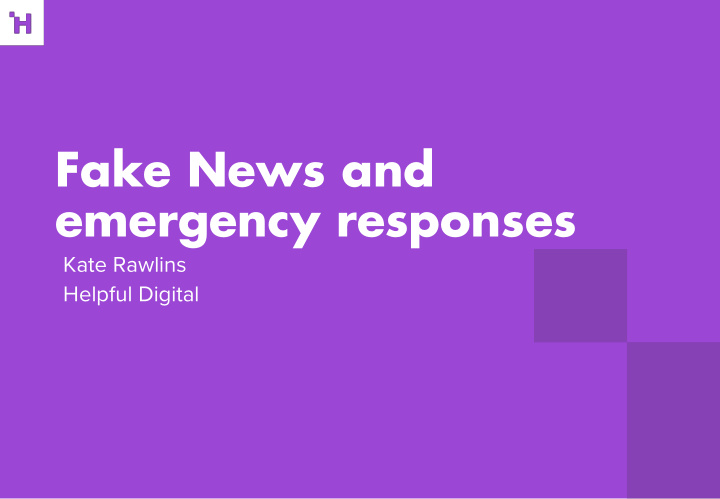



Fake News and emergency responses Kate Rawlins Helpful Digital
@kate_rawlins_ § Specialist in crisis preparedness for digital communications professionals across a range of industries, including: § Security: counter-terrorism & major incidents § Oil and gas § Beauty and consumable product manufacturing § Travel § Banking and finance § Worked on the crisis communication responses for: § Grenfell fire (United Kingdom) § Panama TR4 disease (Australia)
10 types of ‘fake news’
1. Fake News The deliberate publishing of untrue information and disguising it as legitimate.
2. Manipulation The deliberate altering of content to change the meaning.
3. Deepfake The use of digital technology to replicate the live facial movements and voice of another person in a video.
4. Sock puppets The creation of multiple social media personalities of opposing views.
5. Rumour Information shared without verification.
6. Misinformation Typically, a combination of accurate and incorrect content. Think: misleading headlines, using inaccurate sources.
Oldham Hospital
7. Phishing Schemes aimed at unlawfully obtaining personal information from online users
8. Clickbait Sensationalised headlines aimed at attracting attention for readership.
9. Satire & Parody Content created for comic and entertainment purposes.
10. Bot Profiles online that are not operated by humans, nor represent real users.
In an emergency… § Misinformation is inevitable § Not all content is intended to be malicious § Risk needs to inform what we prioritise as important § Understanding the type of content allows for an appropriate response
What is the underlying intent?
Intent to: § Warn and inform ? § Demand a course of action? § Deliberately deceive? The highest risk lies with content that is malicious and aims to purposely misinform audiences.
What is our underlying response objective?
Focus: response objectives § Fact should always set the agenda § Don’t be dragged into misinformed conversations. § Trust and authority is power in uncertain times § Speed is important, but accuracy is just as crucial § Prepare for adapting to an evolving situation § Adapt to change, but don’t lose sight of objectives
Responding well to misinformation starts today…
We’re in the age of the The Golden Minute
Today… § Social media platforms timestamp posts in seconds § Context is often missing, adding to miscommunication and confusion § Push notifications and alerts are instantaneous
Step 1: Monitoring Places to monitor: § Traditional social media channels: Facebook, Twitter, LinkedIn, Instagram § Forums § Tracking radar sites § Press clippings (and comments!)
Step 1: Monitoring Set up a dashboard to monitor: § Mentions of your account § Related hashtags that begin trending § Mentions of the location/s impacted § Trusted voices: § Key staff members § Related stakeholders § Present and future impacted parties
Step 2: Verification A – assume nothing B – believe no one C – challenge everything
Step 2: Verification Details listed in the biographies of profiles
Step 2: Verification Authenticity of images and videos
Rumors are based off speculation; speculation is fed by an absence of fact.
Step 3: Respond § It’s okay not to know it all § Deleting is not an option § Communicate only known information
Step 3: Respond § Close the gap by employing cadence – and stick by promises § Be heard in the places where conversations are happening § Be consistent, everywhere .
Final pieces of advice…
Remember… § Don’t be scared: digital provides just as much opportunity as risk! § Ask: What is the intent? § Prioritise content based on risk § Keep true to the response objectives: facts, authority & trust § Practice your response capabilities
Thank you. Kate Rawlins Free helpful resources: 07429263952 @kate_rawlins_ www.helpfuldigital.com/idr kate@helpfuldigital.com
Recommend
More recommend